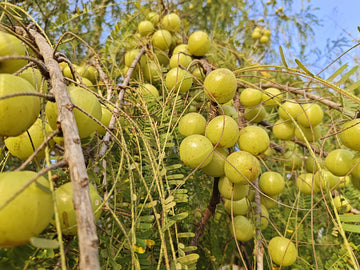The Timeless Power of Amla : A Complete Guide to Its Ancient and Modern Benefits
by Gavatri _ on Mar 05, 2025

Amla, also known as Indian Gooseberry, has been revered in Ayurveda for thousands of years as a powerful rejuvenator. From ancient texts to modern scientific studies, Amla holds a special place in daily wellness routines. Let’s explore its significance through the lens of tradition and modern research.
Amla in Ancient Knowledge : A Gift from Nature
Amla is considered a sacred fruit in Indian traditions and has been referenced in ancient texts like the Charaka Samhita and Sushruta Samhita. In Ayurveda, it is known as ‘Dhatri’—meaning ‘Mother’—as it is believed to nourish the body just like a mother cares for her child. It is classified as a ‘Rasayana,’ which means it supports overall vitality and longevity.
According to Ayurveda :
- Amla balances all three doshas (Vata, Pitta and Kapha), making it a unique and universal remedy for different body types.
- It is believed to strengthen the body's internal balance and support daily wellness.
- The cooling nature of Amla is particularly beneficial for balancing excess heat in the body.
Why Amla is Important in Daily Routine?
In traditional Indian households, Amla has been a part of daily life for generations. Whether consumed fresh, as a juice, or in powdered form. it is cherished for its holistic benefits.
- Supports Daily Energy : Amla is regarded as a natural revitalizer that helps maintain the body's internal strength.
- Digestive Well-Being : It has been traditionally used to support a balanced digestive system.
- Natural Hydration & Cooling : Its natural cooling properties help in maintaining internal balance.
Including Amla in your diet or skincare routine is a step towards embracing an age-old practice that has been valued for centuries.
The Ayurvedic Perspective on Amla
Ayurveda sees Amla as an essential component in maintaining overall well-being. It is used in many classical formulations such as Chyawanprash, Triphala and Brahma Rasayana.
Key Ayurvedic Properties of Amla :
- Rasa (Taste) : Sour, Sweet, Bitter, Astringent, Pungent
- Virya (Potency) : Cooling
- Vipaka (Post-Digestive Effect) : Sweet
- Effect on Doshas : Tridoshic – Balances Vata, Pitta and Kapha
Modern Scientific View on Amla
Modern studies have explored the composition of Amla and its various properties. The presence of certain phytonutrients makes it a subject of interest in modern nutritional research.
- Amla contains natural compounds that are being studied for their potential impact on overall well-being.
- It has been explored for its role in supporting hair and skin health.
- Research indicates that Amla can contribute to digestive health, making it a well-rounded natural ingredient.
Amla for Beauty : A Natural Approach
For centuries, Amla has been a favorite ingredient in hair and skincare rituals. Ancient beauty secrets have celebrated Amla for its ability to enhance natural radiance.
- For Hair : Amla has been used in traditional hair oils and masks to support scalp and hair vitality.
- For Skin : It is included in many skincare formulations that aim to maintain a healthy glow.
Amla’s natural composition makes it a preferred choice in traditional and modern beauty care practices.
Amla for Health and Wellness
Amla is widely used in natural wellness practices due to its well-rounded nature. It can be consumed in various forms:
- Amla Powder : A versatile option for adding to smoothies, herbal drinks or even traditional recipes.
- Amla Juice : A common choice for those who prefer a liquid form.
- Raw Amla : Eating fresh Amla has been a traditional way to experience its natural properties.
Many people incorporate Amla into their lifestyle as part of their daily routine.
Versatile Uses of Amla
Amla’s adaptability makes it a must-have in every home. Here are some traditional and modern ways to use it:
- As a Hair Pack : Mix Amla powder with water or other natural ingredients for a traditional hair mask.
- In Herbal Teas : Amla powder can be added to herbal infusions for a refreshing drink.
- In Cooking : Used in chutneys, pickles and various Indian dishes for added flavor.
- As a Face Mask : Amla is often combined with other natural ingredients for skincare routines.
Disclaimer :
This blog is for informational purposes only and is based on traditional and ancient knowledge of Amla, and does not intend to provide medical advice. Always seek professional guidance for any health-related concerns. Individual experiences may vary.
Precautions :
While Amla is a highly regarded herb in Ayurveda, it is important to use it mindfully. Pregnant and breastfeeding women, as well as individuals with specific health conditions, should consult a qualified healthcare professional before including Amla in their routine. It is advisable to start with small quantities and observe how your body responds. Ayurveda emphasizes personalized wellness, so always listen to your body's needs., embrace natural wellness mindfully and enjoy the benefits of Amla in a balanced way.
Embracing Amla :- A Step Towards Traditional Wellness
Amla is more than just a fruit; it is a timeless companion for those who appreciate natural living. Whether viewed through the wisdom of Ayurveda or the lens of modern research, its significance remains unparalleled. By incorporating Amla into your routine, you embrace a tradition that has been cherished for generations.
Would you like to explore more ways to use Amla in your daily life? Share your thoughts in the comments below.
Ready to experience the benefits of Amla for yourself?
Order now at :- " Gavatri Classic and Natural Amla Powder "— a pure and versatile addition to your daily routine.



